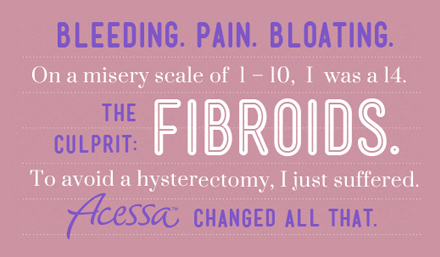Doctors at MacArthur OBGYN are now offering a new surgical technique to treat uterine fibroids as a hysterectomy alternative! It is called Acessa. Fibroids are tumors in the uterus that cause pelvic pain, pressure, and heavy bleeding. Previously, fibroids have been treated with invasive surgeries like myomectomy (fibroid removal) and hysterectomy (uterus removal), however we now offer a new procedure that will treat fibroids without big incisions or damage to your uterus! With Acessa you can avoid a hysterectomy which has been the common procedure before now. Below are some FAQs regarding the new Acessa procedure. Ask your doctor if you are interested.
 What is Acessa?
What is Acessa?
Acessa is a minimally invasive outpatient procedure for the treatment of uterine fibroids. It is done by laparoscopy and uses radiofrequency ablation to shrink and destroy the fibroids. Acessa treats fibroids of all sizes, shapes, and locations within the uterus. Unlike a hysterectomy, the uterus is not removed, and unlike a myomectomy, the wall of the uterus is left unharmed.
How is Acessa performed?
Acessa is done laparoscopically through small incisions using a camera, an ultrasound probe, and the Acessa electrode tip. With adequate visualization of the fibroids using an ultrasound probe against the uterus, a fibroid map can be constructed. Then using the ultrasound as a guide, the Acessa tip is advanced into the fibroid. Once the tip is inside the fibroid, an electrode array is deployed throughout the fibroid, and energy is applied throughout the electrode array, thus destroying the fibroid.
How long does Acessa take?
Acessa is an outpatient surgical procedure which means that you will come in for surgery and go home the same day. The surgery time will depend on how many fibroids you have. It can be as quick as 30 minutes or last for several hours.
How long is the recovery time after Acessa?
Total recovery time is usually around 3-5 days, but most patients will be fully functional by 48 hours.
Is Acessa safe?
Yes. The Acessa procedure has been clinically proven to be a safe treatment option for uterine fibroids. The complication rates are very low. Specific complications should be discussed with your physician prior to the procedure.
How effective is Acessa?
Success rates vary from patient to patient but most patients who undergo the Acessa procedure notice relief in pelvic pain immediately after the procedure. Bleeding is usually improved within 3-6 months but can be as early as the first menstrual period after the procedure.
How can I get scheduled for the Acessa procedure?
Talk to your doctor at MacArthur OB/GYN to see if Acessa is a good option for you. If it is, arrangements will be made to schedule your procedure at one of our hospitals. Soon you can be fibroid-free without the need for major surgery.
Schedule a consultation to see if Acessa™ is right for you.
[/impact_text]

